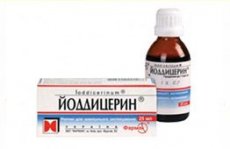Medical expert of the article
New publications
Preparations
Yoddicerin
Last reviewed: 23.04.2024

All iLive content is medically reviewed or fact checked to ensure as much factual accuracy as possible.
We have strict sourcing guidelines and only link to reputable media sites, academic research institutions and, whenever possible, medically peer reviewed studies. Note that the numbers in parentheses ([1], [2], etc.) are clickable links to these studies.
If you feel that any of our content is inaccurate, out-of-date, or otherwise questionable, please select it and press Ctrl + Enter.

Yoddicerin belongs to the pharmacological group of external antiseptic and anti-inflammatory agents.
Indications Yoddicerin
Among the indications for the use of this drug are: purulent wounds, burns, frostbite, purulent inflammatory processes in soft tissues, including gangrene.
The drug is used in gynecology to prevent complications of artificial termination of pregnancy, with mastitis and erosions of the cervix. In dermatology, Yoddicerin is indicated for dermatitis of microbial and viral etiology, pyoderma, herpes; in venereology - with trichomoniasis and gonorrhea; in proctology - with infiltration stages of paraproctitis.
In otorhinolaryngology, Yoddicerin is prescribed for otitis, sinusitis, sinusitis, and in dentistry - for gingivitis, periodontitis and other inflammatory diseases.
Release form
Yoddicerin is available as a sterile solution in a vial and 25 ml dropper bottles; in bottles of 100 ml and 250 ml. In 100 ml of the preparation contains 0.5 g of iodine, 30 g of dimethylsulfoxide (dimexide) and 69.5 g of glycerol.
Pharmacodynamics
The combination of iodine and dimethoxide (dimethyl sulfoxide) provides a high activity of Yoddicerin against a wide range of gram-positive and gram-negative bacteria, other aerobic and anaerobic pathogens, including cocci, salmonella, proteus, clostridia, hemophilic and Pseudomonas aeruginosa.
Iodine shows its bactericidal properties by influencing the synthesis of enzymes of bacteria and the destruction of their protein structures. Dimexide, being in part a transport component of the drug, is able to penetrate freely through the skin and mucous membranes. Getting into tissues, this substance has a local anti-inflammatory and dehydrating effect, which is based on the activation of phagocytes with a simultaneous delay in the signals of the peripheral nervous system and blocking the release of histamine into the bloodstream.
In addition, dimethylsulfoxide ionizes iodine molecules, which leads to an increase in its bactericidal properties directly at the site of purulent inflammation.
Pharmacokinetics
After application to the skin after 10-20 minutes, Iodicidin is absorbed by tissue cells and enters the blood plasma. Dimethyl sulfoxide provides 100% bioavailability of the drug. The therapeutic effect of the drug persists for 8-12 hours.
Elementary iodine partially binds to proteins, partially absorbed by the thyroid gland; Dimexide also binds to plasma proteins and tissues.
From the body the drug is excreted after 28-36 hours (depending on the area of the treated areas) - kidneys, lungs, intestines, milk and sweat glands.
Dosing and administration
Ioddicerin is a topical agent. If the size of lesions or inflammation is insignificant, their abundant treatment with the drug 2-3 times during the day, the duration of the procedures is determined by the degree of healing.
In the case of extensive lesions, Yoddicerin is applied in the form of impregnated dressing gauze bandages (for 25-30 minutes 2-3 times a day). With deeply located lesions in the wound, impregnated tampons or turuns (which can be bandaged, covered with polyethylene film or fixed with adhesive plaster) are injected into the wound. Aseptic treatment of serous cavities, abscesses, abscesses with Joddicerin should be performed by placing drainage only after removal of purulent contents and rinsing.
 [2]
[2]
Use Yoddicerin during pregnancy
Use of Yoddicerin during pregnancy is contraindicated.
Contraindications
Contraindications to the use of Ioddicerin are hypersensitivity to the components of the drug, children under 12 months of age, functional kidney and liver disorders, stroke, myocardial infarction, angina pectoris, atherosclerosis, as well as ophthalmic diseases such as cataract and glaucoma.
Side effects Yoddicerin
If Yoddicerin is applied over a large area, the following side effects may occur:
- dryness and redness of the skin, pain in the place of application;
- dizziness;
- nausea;
- hypo- or hyperthyroidism;
- iodism (runny nose, skin rashes, increased salivation, metallic taste in the mouth, lacrimation, etc.);
- hypernatremia;
- metabolic acidosis;
- spasm of bronchi;
- dysfunction of the kidneys (up to acute renal failure);
- insomnia.
 [1]
[1]
Overdose
Overdose of Yoddicerin is possible due to its ingestion in the volume of 50 to 100 ml. At the same time there is a worsening of health, the appearance of nausea, vomiting, diarrhea, heart rhythm disturbances, etc.
To eliminate the effects of an overdose, the stomach should be washed with sodium thiosulfate in the form of a 0.5% solution.
Interactions with other drugs
Yoddicerin is completely incompatible with most other antiseptics and disinfectants (with hydrogen peroxide, alkalis, mercury compounds and silver preparations).
In acidic medium, Yoddicerin loses its activity. With the simultaneous use of this drug with local products of organic origin, the destruction of protein structures is possible. Yoddicerin neutralizes the effect of enzyme preparations, but enhances the effect of aminoglycoside and beta-lactam antibiotics, nitroglycerin, insulin, butadione. And also increases the sensitivity of the body to drugs for general anesthesia.
 [3]
[3]
Storage conditions
Storage conditions Yoddicerin: in the dark place at room temperature.

Shelf life
Shelf life - 36 months.

Attention!
To simplify the perception of information, this instruction for use of the drug "Yoddicerin" translated and presented in a special form on the basis of the official instructions for medical use of the drug. Before use read the annotation that came directly to medicines.
Description provided for informational purposes and is not a guide to self-healing. The need for this drug, the purpose of the treatment regimen, methods and dose of the drug is determined solely by the attending physician. Self-medication is dangerous for your health.

